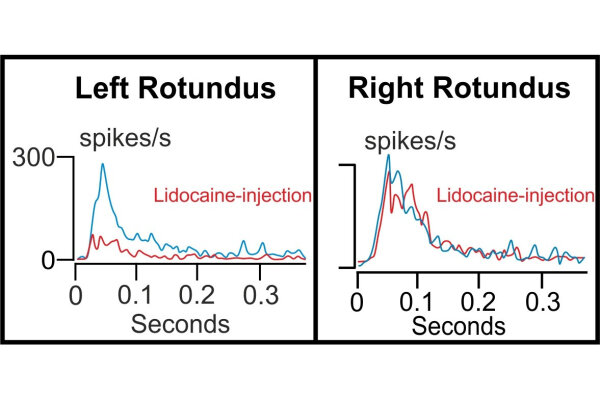2016-03-22

In pigeons, the left hemisphere is associated with the ability to categorize objects based on experience-based behaviors. Why is this so? To find an answer to this question, biopsychologists from Bochum and Tübingen analyzed in detail the descending pathways from the visual forebrain in pigeons. The logic behind this study is the following: If top-down control would be more efficient in the left half brain, experience-based knowledge of the forebrain could modulate left-sided ascending visual information already at thalamic level. To test this idea, single units were recorded from the visual thalamic nucleus rotundus on the left and the right side while the eyes were activated with light flashes. During holding a single unit, the visual forebrain was anesthetized with lidocaine in one hemisphere, thereby blocking top-down influences. Indeed, activity patterns of rotundal neurons were differently modulated by left and right hemispheric descending systems. Thus, visual information ascending towards the left hemisphere was modulated by forebrain top-down systems at thalamic level, while right thalamic units were strikingly less modulated. This asymmetry of top-down control could promote experience-based processes within the left hemisphere, while biasing the right side towards stimulus-bound response patterns. In a subsequent behavioral task the scientists tested the possible functional impact of this asymmetry. Under monocular conditions, pigeons learned to discriminate color pairs, so that each hemisphere was trained on one specific discrimination. Afterwards the animals were presented with stimuli that put the hemispheres in conflict. Response patterns on the conflicting stimuli revealed a clear dominance of the left hemisphere. Transient inactivation of left hemispheric top-down control reduced this dominance while inactivation of right hemispheric top-down control had no effect on response patterns. Functional asymmetries of descending systems that modify visual ascending pathways seem to play an important role in the superiority of the left hemisphere in experience-based visual tasks.

In pigeons, the left hemisphere is associated with the ability to categorize objects based on experience-based behaviors. Why is this so? To find an answer to this question, biopsychologists from Bochum and Tübingen analyzed in detail the descending pathways from the visual forebrain in pigeons. The logic behind this study is the following: If top-down control would be more efficient in the left half brain, experience-based knowledge of the forebrain could modulate left-sided ascending visual information already at thalamic level. To test this idea, single units were recorded from the visual thalamic nucleus rotundus on the left and the right side while the eyes were activated with light flashes. During holding a single unit, the visual forebrain was anesthetized with lidocaine in one hemisphere, thereby blocking top-down influences. Indeed, activity patterns of rotundal neurons were differently modulated by left and right hemispheric descending systems. Thus, visual information ascending towards the left hemisphere was modulated by forebrain top-down systems at thalamic level, while right thalamic units were strikingly less modulated. This asymmetry of top-down control could promote experience-based processes within the left hemisphere, while biasing the right side towards stimulus-bound response patterns. In a subsequent behavioral task the scientists tested the possible functional impact of this asymmetry. Under monocular conditions, pigeons learned to discriminate color pairs, so that each hemisphere was trained on one specific discrimination. Afterwards the animals were presented with stimuli that put the hemispheres in conflict. Response patterns on the conflicting stimuli revealed a clear dominance of the left hemisphere. Transient inactivation of left hemispheric top-down control reduced this dominance while inactivation of right hemispheric top-down control had no effect on response patterns. Functional asymmetries of descending systems that modify visual ascending pathways seem to play an important role in the superiority of the left hemisphere in experience-based visual tasks.